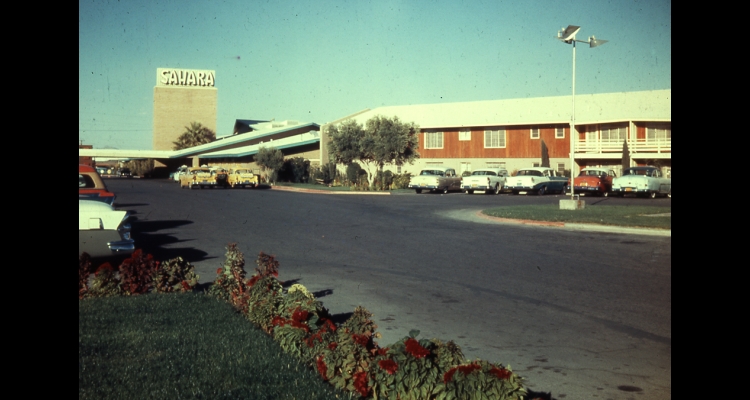Sahara
When the troubled Club Bingo resort, on the northern end of the Las Vegas Strip, went bankrupt in 1950 after three years in business, its operator, former Los Angeles jeweler Milton Prell, saw a chance for recovery by building a new hotel-casino, which he would call the Sahara. Prell talked Desert Inn hotel investor A. Pollard Simon into raising the money for it, and convinced Flamingo Hotel builder Del Webb to construct the Sahara in exchange for a twenty percent ownership share.
When it debuted on October 7, 1952, the Sahara—which cost Prell, Simon, and other investors $5.5 million to build—was the sixth hotel on the Strip, and an instant hit with tourists. A single story high, with 276 rooms, the Sahara, themed after the Moroccan desert in northern Africa, had the largest swimming pool in town, and its dinner theater had the largest seating capacity. Two large statues of camels fronted the hotel. Prell, who nicknamed the place "The Jewel in the Desert," used early profits to build another 200 rooms only a year later.
Headlining the opening night's entertainment at the hotel's Congo Showroom was Ray Bolger, a popular singer and dancer made famous as the scarecrow in the 1939 film, "The Wizard of Oz." Only weeks earlier, the Sahara had pestered Bolger about doing a stint at the hotel. Bolger, on the advice of his wife, requested a salary so high ($20,000 a week) that "they won't hire you." But the hotel accepted the offer, and, with his wife in tow, Bolger came to Las Vegas.
The hotel soon enjoyed another publicity coup thanks to German-born film actress-singer Marlene Dietrich, who shocked her early-1950s audiences by performing—looking almost nude—in a sheer, "peek-a-boo" dress. Photos of her were published across the country. Dietrich's high salary of $30,000 a week for three weeks also upped the stakes in the fast-growing Las Vegas entertainment scene, where competing hotels were constantly outbidding one another to sign top-name talent.
The Sahara also had a strong executive team. Sam Boyd worked there before opening another Prell operation, the downtown Mint. Longtime Las Vegas publicist and promoter Herb McDonald held a management position. Veteran entertainment executives Bill Miller and Stan Irwin imported big-name performers, and little-known ones who became big names.
A popular celebrity hangout, if not associated with sophistication as much as the Sands Hotel, the Sahara prospered in the 1950s. Its Casbar lounge served as the venue for up and coming talent, including young comedian Don Rickles, and for veteran entertainers like Louis Prima, whose show became one of the most successful lounge acts in Las Vegas. In 1960, the hotel opened a fourteen-story tower, then the tallest building in Nevada.
Prell sold his holdings in the Sahara and two other Las Vegas casinos in 1961 to Webb for $100 million. The arrangement made history, as Webb's Sahara-Nevada Corporation became the first public company to own Nevada casinos. Webb had to set up different corporations to run his Las Vegas operations, since it would be difficult, if not impossible, for publicly traded corporations to own casinos until the Corporate Gaming Act of 1969. Webb debuted a twenty-four-story hotel tower in 1963, with 400 rooms. In 1964, Irwin, the Sahara's entertainment director, booked the British pop music group, the Beatles, to perform at the Sahara, but sold so many tickets that the concert was moved to the Las Vegas Convention Center. The Beatles stayed for free at a twenty-third floor suite in the Sahara's new tower during their tour stop in Las Vegas.
In the 1980s, Webb's company sold the Sahara, and the Hacienda Hotel at the south end of the Strip, to Paul Lowden, a former musician who had performed at Strip hotels. Lowden sold the Sahara in 1995 to William Bennett, the former executive with the Circus Circus and Excalibur hotels, for $193 million.
Bennett invested $100 million to refurbish the Sahara's hotel rooms, casino, and restaurants. In 2000, he added a $50 million NASCAR exhibit and cafe, with twenty authentic racing cars on display, along with interactive arcade games and a roller coaster, named SPEED, that ran from inside the casino and outside on the Strip and back again. Appropriately, Bennett also was involved in building the Las Vegas Motor Speedway.
After Bennett's death in 2002, the Sahara remained the property of his company, Gordon Gaming Corporation. By the mid-2000s, the Sahara had 1,750 hotel rooms, 80,000 square feet of casino area, a 5,000-square foot swimming pool, and remained associated with NASCAR.
The Sahara closed on May 14, 2011 after fifty-nine years of operation. The closing was a quiet affair, with various restaurants, nightclubs, and the Sahara's "The Ride" roller coaster gradually ceasing operations over the previous few weeks. Action on the casino floor ceased at 10 a.m., the morning of May 14.
Article Locations
Related Articles
None at this time.

